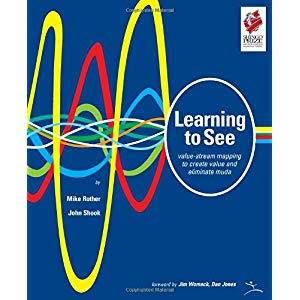This post is about how I run a value stream mapping workshop as part of an Agile/Lean readiness assessment or as part of ongoing process improvements.
 Value Stream Map’s are very useful for understanding how your current process works. My initial understanding came via Mary Poppendieck (books and training). Later I learned the details from the book Learning to See: Value Stream Mapping to Add Value and Eliminate MUDA by Mike Rother and John Shook; it’s all about manufacturing but the principles hold.
Value Stream Map’s are very useful for understanding how your current process works. My initial understanding came via Mary Poppendieck (books and training). Later I learned the details from the book Learning to See: Value Stream Mapping to Add Value and Eliminate MUDA by Mike Rother and John Shook; it’s all about manufacturing but the principles hold.
Workshop is ~10 people x 3 hours
For this meeting, I ask for a cross-functional group that can define the steps involved with going from concept to cash. This group may be in the 5 to 15 person range depending on the organization. Depending on how many people you have you may want to split them into multiple groups. Groups can do the same or different processes. My rule is to get to as small a group as you can and still have enough knowledge of the process.
With regard to time – 2 hours may be enough for a small company while a large bank may require the full 3 hours.
Slides used to Introduce Value Stream Mapping
Below are the slides I use to introduce the workshop. Mostly you’ll just see pictures that I use to introduce the concepts, so you gotta know this stuff well. In addition to value stream mapping, I talk about Muri, Mura, Muda and have them think about the 7 types of waste.
Explain how to create a Map
Before starting the exercise, I run through creating a value stream map with them so they get a feel for how it works and agree on conventions.
 As people indicate what the steps in the value stream map are, I write up each step and create the legend shown on the left. It doesn’t really matter what process you use – the point of this part is to give them a feel for identifying each of the parts. Go through a few steps until you can see they are getting the hang of it. Remember to write the time on value added and waste stickies (missing in legend).
As people indicate what the steps in the value stream map are, I write up each step and create the legend shown on the left. It doesn’t really matter what process you use – the point of this part is to give them a feel for identifying each of the parts. Go through a few steps until you can see they are getting the hang of it. Remember to write the time on value added and waste stickies (missing in legend).
Size matters. Queue size, that is. It is important to show how much WIP (work-in-process) there is at each step. People often know things like: we have a product roadmap with 200 features in it or 9 features waiting for development.
Some teams may not feel comfortable identifying any activities as waste. That’s OK. They may not be ready for that yet.
Mapping Exercise
It helps to pick a concrete project that is typical for the organization. Something like an average feature, typical client request or urgent defect fix. This helps people move away from a conceptual process to talk about what actually happens in real life.
It is a good idea to warn people that they may be surprised with how things actually work. Taiichi Ohno, one of the founders of Toyota Production System, joked that it is good to have a poor starting place so there are easy opportunities to show process improvement.
During the exercise, I float between the groups to answer questions and make sure things are on track. After about 20 minutes the teams are usually cooking and can proceed on their own.
Once everyone is finished, each team presents it’s value stream map to the large group. Sometimes there are minor corrections, but these are usually fine details that don’t change the big picture.
Example Value Stream Map
Below is an example (click for a large image) of a completed value stream map for funded development at a 50 person product company. In this particular case, the company noticed that 5 days of planned work actually took 15 days (with rework) plus another 10 days of waste due to communication overhead.

Special enhancements:
- Along the top we have communication waste – this is the extra time needed to manage a project in a dysfunctional process that spans 9 months.
- Below the main flow we have rework arrows. Each arrow indicates the % chance that the work item needs to return to an earlier step. As can be seen, there are multiple return trips after reaching production.
Debrief with management
At the start, I explain the overall activity and its purpose. Together with some of the original authors of the map, we walk through the steps. I stick to explaining the Value Stream Map concepts and let others explain the content. Managers are usually surprised at how long it takes to complete work.
It is especially important to clarify that we are talking about the Lean concept of system efficiency – defined as time working on product/elapsed time. This will be unrelated to other measures of efficiency at the company.
The usual follow-up on this workshop is one to specify the desired future state. Of course, all of this is a great candidate for using the A3 technique.


